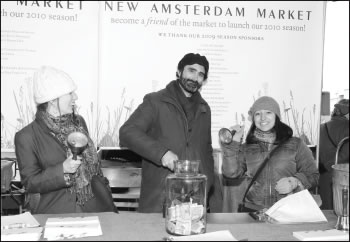BY Terese Loeb Kreuzer
Over the last few years as plans have surfaced for the former Fulton Fish Market on South Street that included high-rise hotels and apartment buildings, an ex-city planner with a passion for food has been battling to keep the area firmly rooted in its history.
Robert LaValva, who holds an architecture degree from N.Y.U., is the architect of the New Amsterdam Market, which he founded in 2005 to sell regionally sourced food. At first just a yearly venture, then monthly and then weekly, the New Amsterdam Market will open on South Street between Beekman Street and Peck Slip on May 1. The market will be open every Sunday from 11 a.m. to 4 p.m. through December.
“This has always been a market district,” he said. “When the Fulton Fish Market left, it seemed like a market should still be here.”
LaValva said that he was inspired by European market districts such as Les Halles in Paris — now gone and lamented as a loss to the city — and by the covered market halls of Great Britain such as London’s Borough Market.
New York has also had a long tradition of public markets, he pointed out, including the Fulton Fish Market, which decamped to the Bronx five years ago, and the long-gone Washington and Jefferson Markets, which sold produce and fish. He said that these markets were praised for their quality and attracted local, regional and even international visitors.
Although relatively new as markets go, the New Amsterdam Market has already attracted a national and international following.
“The market has been written about in newspapers and journals in Denmark, Mexico, Japan and Germany, that we know of,” LaValva said, “and we’re starting to get letters and emails from people in Canada and from all over the United States.”
He said he recently got an email from an Italian woman who will be visiting New York in April and was upset that the market would not yet be open for the season. “She said, ‘We want to visit places that reflect the history and character of the city that we’re visiting and we want to see this market,’” LaValva recounted. “We see the market as something that can benefit residents, the vendors and the City as a whole through tourism.”
He also mentioned that the market has served as an incubator for small businesses. “Several got their start at the market,” he said.
LaValva does not receive a salary for directing the New Amsterdam Market. This season, he expects to have 45 to 50 vendors a week selling produce, dairy products, meat, bread, candy, ice cream, beverages, and more.
“A market takes a long time to build,” he commented. “It’s not always been easy to use the [South Street] site. There have been other visions and other proposals for what to do there, but we have worked collaboratively with the City.”
Fund-raising has been another challenge, he said.
On March 26 from 1 p.m. to 4 p.m., Jimmy Carbone of Jimmy’s 43 at 43 E. 7th Street, will hold a brisket cook-off to benefit the New Amsterdam Market. Amateur and professional cooks will prepare their favorite recipes — traditional, cross-cultural, pastrami or corned beef — with a winner selected by judges from the James Beard Foundation, Saveur magazine, the Village Voice and elsewhere. Tickets are $20 at the door, or $45 by advance purchase, conferring early admission. For more information, go to www.brownpapertickets.com/event/164666.
A second fundraiser will take place on April 9 — an Oyster Saloon on South Street between Fulton and Beekman Streets, from 5 p.m. to 10 p.m.
“For the oyster event, we’ll be getting oysters from all over the East Coast,” LaValva said. He noted that East Coast oysters are mostly of one species but taste different depending on the salinity of the water, whether they’re near a stream, which kind of algae are present in the water and other factors.
“Oyster saloons are an interesting part of our local history,” LaValva commented. “Oysters have been consumed along the East River for thousands of years. Native Americans came where the Seaport is now to dig up and eat oysters. In the 19th century, the oyster saloons became staples where you could get shucked oysters of all types. As well, there were many oyster preparations. One famous one was the pan roast, where you would cook oysters with butter and cream and some seasonings and we’re really excited that April Bloomfield of The Spotted Pig and the John Dory Restaurant, who has re-popularized pan roasts, is going to be coming to our event and making the pan roast.”
At the Oyster Saloon, regional cask beer will be served with the oysters, which is what would have happened in the oyster bars that were ubiquitous in Lower Manhattan in the 19th century.
“We try to connect New Yorkers with their history,” LaValva said.
Tickets for the Oyster Saloon are $50. A special “Founders Circle” event will kick off the evening at Pasanella & Son Vintners at 115 South Street with a toast and a talk by restaurant critic Mimi Sheraton and oyster hors d’oeuvres by the Canal House of Lambertville, N.J. To buy tickets or for more information, go to www.newamsterdammarket.com/events.html
































